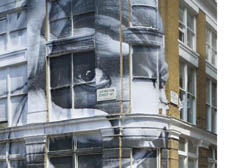| |
 JR’s subject might be peeping, but passers-by can’t help but stop and stare at his massive work in Lexington Street. JR’s subject might be peeping, but passers-by can’t help but stop and stare at his massive work in Lexington Street. |
West End | News | Bansky | JR | French graffiti artist | vandals | Lexington Street |Tate Modern | Art
Move over Banksy – here comes JR and he doesn’t care if he has permission or not
BANKSY does it, vandals do it, even agitated protesters do it – the artful defacement of private property has become something of a national pastime.
Now the French have raised London’s street art stakes with their own version of Banksy conquering the West End with a controversial set of house-sized fly posters.
The picture on the right shows the scene in Lexington Street in Soho where passers-by can’t help but stop and look at the giant face staring back at them.
And below is the stunning sight in Herbrand Street in Bloomsbury, where residents woke up last week to find one of the enormous murals commanding the entire side of a listed four-storey house.
When the West End Extra tracked down the man responsible – the mysterious photographer known only as “JR” – at his hideaway in France on Monday, he claimed his art was “for everybody”.
Everyone, however, is not so sure.
Westminster’s Conservative planning chairman Councillor Robert Davis said: “The artwork on the side of 40-42 Lexington Street requires advertisement consent. No such consent has been applied for. Our planning enforcement team are now investigating and may take formal enforcement action to have the artwork removed.”
Meanwhile, the display in Herbrand Street, which coincides with Tate Modern’s Street Art exhibition in which JR features, has also stoked controversy, rousing the ire of some neighbours and conservationists, who say the artist acted without permission in their street as well.
Even the property’s landlord, Michael Bucknell, insists he wasn’t asked whether he thought it was a good idea.
“I didn’t know anything about it because it was done without permission,” he said. “My handyman called me and said: ‘You’ve got the biggest poster in London on your building,’ and I fainted. I called the people who had put it up and asked them to remove it immediately. They said it would be removed within a week but it is still there.”
The Lazarides Gallery, who commissioned the murals and is also currently exhibiting JR’s work, said “as far as they were aware” permission had been agreed.
Planning enforcers are only likely to be drawn into the row if the mural causes damage to the building.
JR, who keeps his identity anonymous due to the nature of his work, said: “I didn’t deal with the authorisation of the piece but the fact it was illegal makes it cooler for me. It’s a mural, it’s there for a period of time and can come off very easily.
“If people don’t like it they can criticise it or scratch it off. It’s not my piece of art any more, it’s in the street for everybody. The only mark that stays is the one on people’s minds.”
Bill Reed, chairman of the Bloomsbury Conservation Area Advisory Committee, added: “The wall is unlikely to revert to its former self. Whilst many sites can benefit from this sort of thing, a listed building in a conservation area definitely doesn’t. Furthermore, there is an inherent risk in turning a blind eye to this sort of thing: if it’s OK for ‘art’ installations to go up without planning, where does art stop and advertising start?” |
 |
|
| |
| |